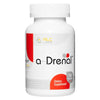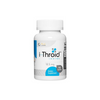New website, same quality supplements & vitamins! Share feedback

What You Need to Know About Air Purifiers
You likely know that it’s harmful to breathe in polluted air when you’re outside; the same is true when you’re indoors too! Did you know that stale indoor air, toxins introduced into your home, and heating/cooling systems can exacerbate conditions like asthma, COPD, and respiratory triggers?
Given that we spend nearly 90% of our time indoors[1] – at home, at work, or at school it is crucial to give attention to indoor air quality. According to the U.S. EPA (Environment Protection Agency), the concentrations of some pollutants are often 2 to 5 times higher than typical outdoor concentrations[2].
Many factors from energy-efficient buildings that restrict ventilation, to furnishings, pesticides, household cleaners, and even personal care products can all contribute to indoor air pollution. Besides these man-made conditions, natural contaminants like microbes, pet dander, dust, and pollen also affect indoor air quality.
How indoor air quality affects your health?
Too many circulating pollutants in your indoor environment influence your health in many ways. Here are some common issues that are often overlooked,
- Irritation of eyes, nose, and throat.
- Frequent respiratory infections, allergies, and illnesses.
- Exacerbated asthma, COPD.
- Chronic fatigue, dizziness, sleepiness, headache, and even digestive issues.
Who is at risk of indoor air pollution?
Everyone is at risk of health issues from poor indoor air quality. However, specific groups are more affected, such as, people with lung conditions like COPD, bronchiectasis, or asthma. Newborns and young children are vulnerable since their lungs are still developing. Since their airways are smaller, pollutants can narrow them more easily than in adults. To reduce the risk of respiratory illness, it is recommended to keep your indoors clean by dusting often, removing clutter, and investing in an air purifier to improve indoor air quality.
Dr.Nicholas BuSaba, Associate professor of Otolaryngology at Harvard Medical School, recommends investing in an air purifier as an effective way to minimize indoor air pollutants(3). He particularly recommends ionic purifiers because they efficiently capture many of the irritants. This may reduce triggers to respiratory symptoms and improve air quality.
Points to keep in mind when buying air purifiers
Advanced technology that delivers: An air purifier that uses advanced technology could be convenient, efficient, and reliable. UV-light air purifiers and ionizers are popular because they have minimal maintenance and are highly efficient.
Air purifiers and room size: Always choose air purifiers based on your room size. A portable air purifier cannot efficiently work in a larger room. Inquire about the right size for your space and or the entire home if you are not sure which size is best for you.
Quiet: Air purifiers are supposed to work 24 x7, and a noisy air purifier is not a good idea. Choose air purifiers that operate quietly throughout the day.
Categories of air pollutants treated: Choosing an air purifier that works to treat all categories of air pollutants is a better choice. The three common categories include microbial ( germs, fungi or mold ad viral), chemical vapors or organic odors (bleach or ammonia and rotten eggs or smelly pets), and particulate (pollen, dust, smoke, and pet dander).
Ionizing air purifiers & ozone output: Ionizing air purifiers are efficient because they use UV light technology to generate negative charges. Since the indoor pollutants have a positive charge and the technology has a negative charge, it is drawn magnetically out of the unit and into the treatment area. This is why you do not need either a fan or a filter. When choosing an ionizing air purifier, it is essential to check the ozone output. It is best to use an ionizing purifier that generates minimal ozone output.
Ways to get the most of your air purifiers
Clean or replace your air filters: If you choose an air purifier with a filter, it is crucial to replace air filters or clean those that can be vacuumed periodically. Ideally, filters every six to twelve months for pleated filter types and every three months for carbon filters. If using ionic air purifiers, you will need to replace your lamp module once a year. If you notice discoloration or frosted over appearance on the lamp of your ionic air purifier, it indicates that it is time to replace the lamp.
Maximize your air purifier’s function: Many pollutants are lighter than air and tend to rise. It is an excellent idea to locate your unit head high, usually 5-6 feet above the floor, on a bookshelf, or on top of your refrigerator. This ensures that your breathing space is treated first.
Multiple units: A single purifier may not take care of the entire home depending on its size. Using multiple units for larger areas offers excellent results. Alternatively, you could also locate your unit in a particularly offensive or strong area, such as near a litter box or in the kitchen, to eliminate a specific problem and later move it to a centralized location in the area you are treating.
If you are looking for hassle-free air purifier options, CAMFormulas presents PionAIR Smart Pointe air treatment system that is convenient and efficient. PionAIR uses ionizing air purifier technology to purify indoor air. You can shop three models – 350, 750, and 1500, depending on your room size.
PionAIR Smart Point Air Treatment System 350 sq ft: The 350 models treat up to 350 sq. feet and are best for single rooms, like offices or bedrooms.
PionAIR Smart Point Air Treatment System 750 sq ft: PionAir 750 models treat up to 750 sq. feet and are best for combination rooms, like a kitchen/dining room.
PionAIR Smart Point Air Treatment System 1500 sq ft: Ideal to treat up to 1500 sq. feet and are best for large open areas or most apartments or condos.
Keep in mind, it is essential to allow fresh air to move into the house when possible, even in the cold months. This allows for improved air circulation and lowers pollutants.
References
[1] U.S. Environmental Protection Agency. 1989. Report to Congress on indoor air quality: Volume 2. EPA/400/1-89/001C. Washington, DC.
[2] U.S. Environmental Protection Agency. 1987. The total exposure assessment methodology (TEAM) study: Summary and analysis. EPA/600/6-87/002a. Washington, DC.
3. https://www.health.harvard.edu/staying-healthy/easy-ways-you-can-improve-indoor-air-quality





